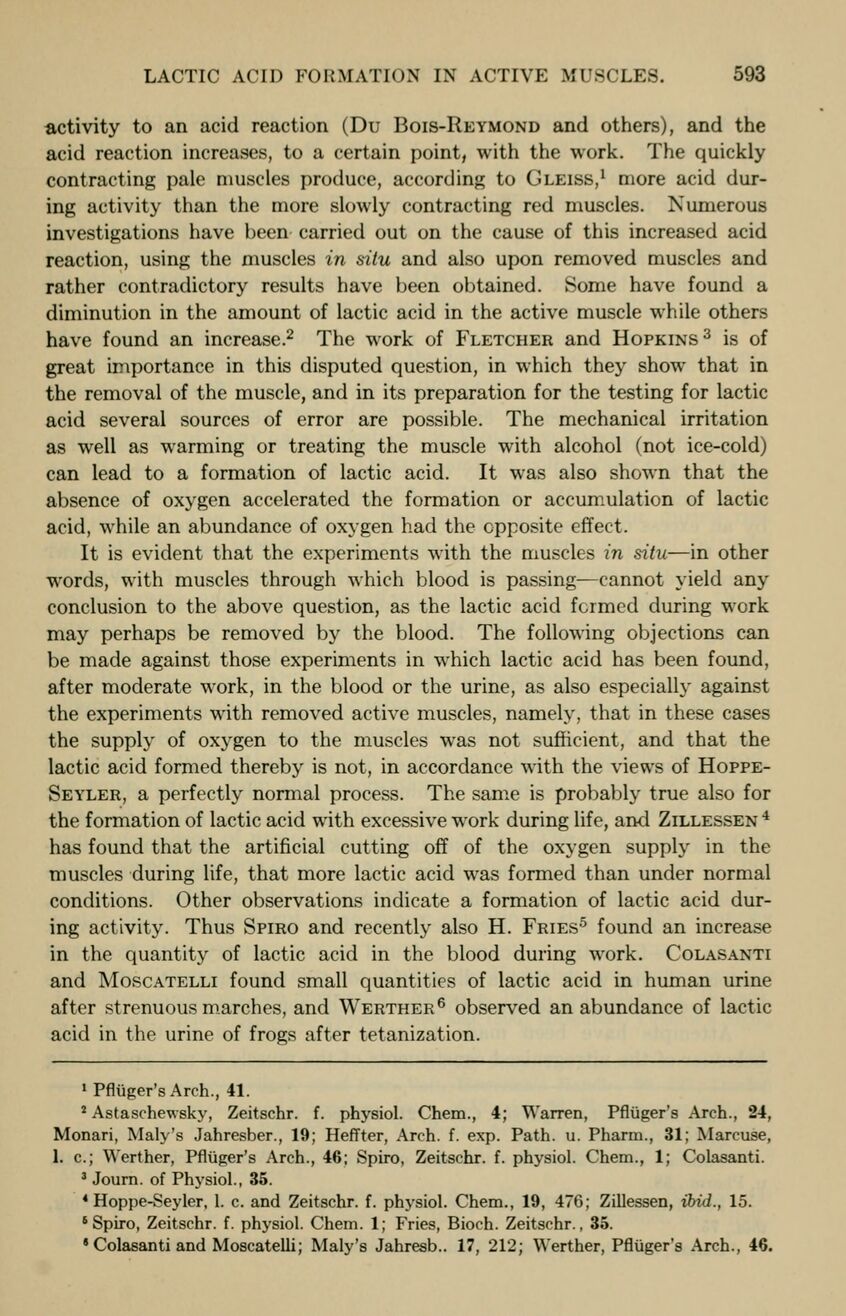
Full resolution (JPEG) - On this page / på denna sida - X. The Muscles - Extractive Bodies of the Muscles

<< prev. page << föreg. sida << >> nästa sida >> next page >>
Below is the raw OCR text
from the above scanned image.
Do you see an error? Proofread the page now!
Här nedan syns maskintolkade texten från faksimilbilden ovan.
Ser du något fel? Korrekturläs sidan nu!
This page has never been proofread. / Denna sida har aldrig korrekturlästs.
LACTIC ACID FORMATION IN ACTIVE MUSCLES. 593
activity to an acid reaction (Du Bois-Reymond and others), and the
acid reaction increases, to a certain point, with the work. The quickly
contracting pale muscles produce, according to Gleiss, 1
more acid dur-
ing activity than the more slowly contracting red muscles. Numerous
investigations have been carried out on the cause of this increased acid
reaction, using the muscles in situ and also upon removed muscles and
rather contradictory results have been obtained. Some have found a
diminution in the amount of lactic acid in the active muscle while others
have found an increase.2
The work of Fletcher and Hopkins 3
is of
great importance in this disputed question, in which they show that in
the removal of the muscle, and in its preparation for the testing for lactic
acid several sources of error are possible. The mechanical irritation
as well as warming or treating the muscle with alcohol (not ice-cold)
can lead to a formation of lactic acid. It was also shown that the
absence of oxygen accelerated the formation or accumulation of lactic
acid, while an abundance of oxygen had the opposite effect.
It is evident that the experiments with the muscles in situ—in other
words, with muscles through which blood is passing—cannot yield any
conclusion to the above question, as the lactic acid formed during work
may perhaps be removed by the blood. The following objections can
be made against those experiments in which lactic acid has been found,
after moderate work, in the blood or the urine, as also especially against
the experiments with removed active muscles, namely, that in these cases
the supply of oxygen to the muscles was not sufficient, and that the
lactic acid formed thereby is not, in accordance with the views of Hoppe-
Seyler, a perfectly normal process. The same is probably true also for
the formation of lactic acid with excessive work during life, and Zillessen 4
has found that the artificial cutting off of the oxygen supply in the
muscles during life, that more lactic acid was formed than under normal
conditions. Other observations indicate a formation of lactic acid dur-
ing activity. Thus Spiro and recently also H. Fries5
found an increase
in the quantity of lactic acid in the blood during work. Colasanti
and Moscatelli found small quantities of lactic acid in human urine
after strenuous marches, and Werther 6
observed an abundance of lactic
acid in the urine of frogs after tetanization.
1
Pfliiger’s Arch., 41.
2
Astaschewsky, Zeitschr. f. physiol. Chem., 4; Warren, Pfliiger’s Arch., 24,
Monari, Maly’s Jahresber., 19; Heffter, Arch. f. exp. Path. u. Pharm., 31; Marcuse,
1. c; Werther, Pfliiger’s Arch., 46; Spiro, Zeitschr. f. physiol. Chem., 1; Colasanti.
3
Journ. of Physiol., 35.
4
Hoppe-Seyler, 1. c. and Zeitschr. f. physiol. Chem., 19, 476; Zillessen, ibid., 15.
6
Spiro, Zeitschr. f. physiol. Chem. 1; Fries, Bioch. Zeitschr., 35.
•Colasanti and Moscatelli; Maly’s Jahresb.. 17, 212; Werther, Pfliiger’s Arch., 46.
<< prev. page << föreg. sida << >> nästa sida >> next page >>